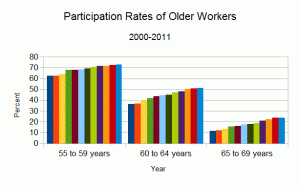When Will The Baby Boomers Retire?
Canada’s population, we are frequently told, is rapidly aging. The big baby boomer cohort is headed out of the workforce, meaning that we face a future of very slow labour force growth and even possible shortages of workers. CIBC Economics has just gone so far as to argue that the Bank of Canada can afford to be more relaxed about unemployment due to demographic changes which will lower the demand for jobs.
Canada’s rate of labour force growth will indeed be slowing. Everybody gets one year older with every year that passes, and the large baby boom generation will indeed stop working some day. We do already see some shortages of workers with specific skill sets in specific areas of the country.
But it is worth underlining that the immediate issue – and the issue that will last for several more years at least – is high unemployment, NOT generalized labour shortages. We do not have enough jobs to employ both the baby boomers who are putting off retirement, and their children who are still entering the work force in large numbers.
If we look at the data for older workers for 2000 to 2011, we see two things. The number and proportion of of older workers aged 55 and over has been increasing as the population ages. This depresses the labour force participation rate to some degree, as older workers are less likely to participate than core age workers aged 25 to 54. But, and this is a very big but, the participation rate of older workers has been steadily and quite dramatically rising.
As shown in the Chart below, the participation rate of all sub groups of older workers has been rising steadily since 2000, from 62.7% to 73.0% for persons aged 55 to 59; from 36.2% to 51.1% for those aged 60 to 64, and from 11.4% to 23.9% for those aged 65. to 69. The increase has been especially pronounced for women. In 2011, the participation rate for women aged 60 to 64 was 44.5%, up from 27.0% in 2000, and the participation rate of women aged 65 to 69 was 18.2% compared to just 7.1% in 2000. (Data from CANSIM Table 282-0002.)
While the leading edge of the baby boom generation are now entering their 60s., the bulk of them are just entering the 55 to 59 age group, and many seem set to stay in the workforce for many years, particularly if the labour force participation rates of those in their 60s continues to increase in the future as it has in the past decade.
No one can forecast the future trend with certainty, but but it can be noted that there was an especially big jump in the participation rate of older workers after the stock market collapse of 2002. (The participation rate of those aged 55 to 59 jumped from 63.8% to 67.7% between 2003 and 2011.) The decline of defined benefit pension plan coverage combined with big hits to retirement savings because of low interest rates and depressed equities seem to have definitively killed “Freedom 55.”
In sum, the work force may be aging, but not enough to stop us from worrying about unemployment.


‘Freedom 55’ is not a term I have heard in the UK, but I can relate to your article. Many in the population rely on state benefits alone and barely survive retirement. The problem is the state pension age is constantly being increased to the point where I expect for me it will be 70. I then ask myself, could I even work until this age due to health etc, what would I do without my own pension provision?
The average pension pot in the UK is £27,000 a measly figure to fund the suppossed best years of your life! As you put ‘The decline of defined benefit pension plan coverage combined with big hits to retirement savings because of low interest rates and depressed equities’ has definately dashed many peoples hope or retiring anytime before they are 65!